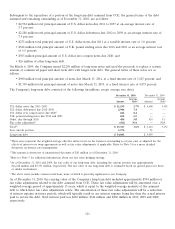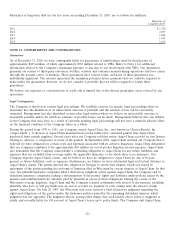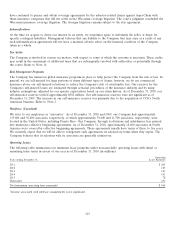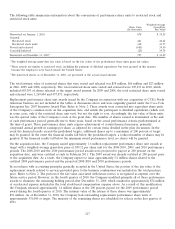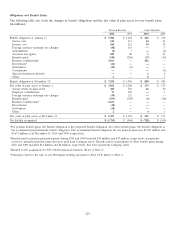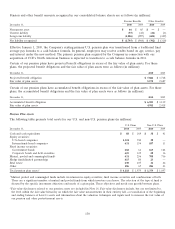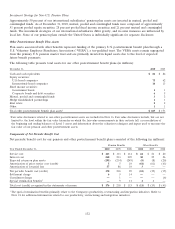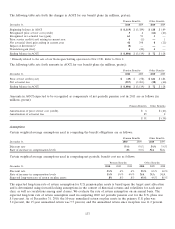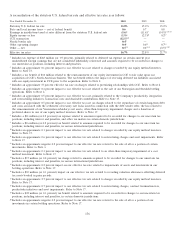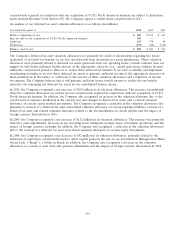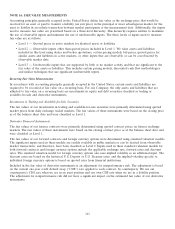Coca Cola 2010 Annual Report Download - page 133
Download and view the complete annual report
Please find page 133 of the 2010 Coca Cola annual report below. You can navigate through the pages in the report by either clicking on the pages listed below, or by using the keyword search tool below to find specific information within the annual report.Investment Strategy for U.S. Pension Plans
In 2010, our U.S. pension plan assets increased significantly as a result of our acquisition of CCE’s North American
business. Assets included in our primary U.S. plans increased from $1.9 billion as of December 31, 2009, to $3.6 billion
as of December 31, 2010, as a result of positive asset performance and the acquisition. The allocation of pension assets
acquired will be assessed and consideration given as to how the investment strategy of the combined assets will be
aligned to provide an allocation that supports the Company’s investment goals for pension assets. We do not anticipate
that the ultimate allocation will be significantly different from our current investment strategies. Our investment
strategies are described below.
The Company utilizes the services of investment managers to actively manage the pension assets of our primary
U.S. plans. We have established asset allocation targets and investment guidelines with each investment manager. Our
asset allocation targets promote optimal expected return and volatility characteristics given the long-term time horizon
for fulfilling the obligations of the plan. Selection of the targeted asset allocation for U.S. plan assets was based upon a
review of the expected return and risk characteristics of each asset class, as well as the correlation of returns among
asset classes. Our target allocation is a mix of approximately 60 percent equity investments, 30 percent fixed income
investments and 10 percent in alternative investments. Furthermore, we believe that our target allocation will enable us
to achieve the following long-term investment objectives:
(1) optimize the long-term return on plan assets at an acceptable level of risk;
(2) maintain a broad diversification across asset classes and among investment managers;
(3) maintain careful control of the risk level within each asset class; and
(4) focus on a long-term return objective.
The guidelines that have been established with each investment manager provide parameters within which the
investment managers agree to operate, including criteria that determine eligible and ineligible securities, diversification
requirements and credit quality standards, where applicable. Unless exceptions have been approved, investment
managers are prohibited from buying or selling commodities, futures or option contracts, as well as from short selling of
securities. Additionally, investment managers agree to obtain written approval for deviations from stated investment
style or guidelines. As of December 31, 2010, no investment manager was responsible for more than 10 percent of total
U.S. plan assets.
Our target allocation of 60 percent equity investments is composed of approximately 33 percent domestic large-cap
securities, 33 percent domestic small-cap securities, 19 percent international securities and 15 percent domestic mid-cap
securities. Optimal returns through our investments in domestic large-cap securities are achieved through security
selection and sector diversification. Investments in common stock of our Company accounted for approximately
13 percent of our investments in domestic large-cap securities and approximately 3 percent of total U.S. plan assets.
Our investments in domestic mid-cap and small-cap securities are expected to experience larger swings in their market
value on a periodic basis. Our investments in these asset classes are selected based on capital appreciation potential.
Our investments in international securities are intended to provide equity-like returns, while at the same time helping to
diversify our overall equity investment portfolio.
Our target allocation of 30 percent fixed income investments is composed of 50 percent long-duration bonds and
50 percent high-yield bonds. Long-duration bonds provide a stable rate of return through investments in high-quality
publicly traded debt securities. Our investments in long-duration bonds are diversified in order to mitigate duration and
credit exposure. High-yield bonds are investments in lower-rated and non-rated debt securities, which generally produce
higher returns compared to long-duration bonds. Investments in high-yield bonds also help diversify our fixed income
portfolio.
In addition to investments in equity securities and fixed income investments, we have a target allocation of 10 percent
in alternative investments. These alternative investments include hedge funds, private equity limited partnerships,
leveraged buyout funds and international venture capital partnerships. The objective of investing in alternative
investments is to provide a higher rate of return than that available from publicly traded equity securities. These
investments are inherently illiquid and require a long-term perspective in evaluating investment performance.
131


